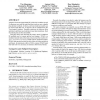Free Online Productivity Tools
i2Speak
i2Symbol
i2OCR
iTex2Img
iWeb2Print
iWeb2Shot
i2Type
iPdf2Split
iPdf2Merge
i2Bopomofo
i2Arabic
i2Style
i2Image
i2PDF
iLatex2Rtf
Sci2ools
KBSE
2007
IEEE
2007
IEEE
The business case for automated software engineering
Adoption of advanced automated SE (ASE) tools would be favored if a business case could be made that these tools are more valuable than alternate methods. In theory, software prediction models can be used to make that case. In practice, this is complicated by the ”local tuning” problem. Normally, predictors for software effort and defects and threat use local data to tune their predictions. Such local tuning data is often unavailable. This paper shows that assessing the relative merits of different SE methods need not require precise local tunings. STAR1 is a simulated annealer plus a Bayesian post-processor that explores the space of possible local tunings within software prediction models. STAR1 ranks project decisions by their effects on effort and defects and threats. In experiments with two NASA systems, STAR1 found that ASE tools were necessary to minimize effort/ defect/ threats. Categories and Subject Descriptors I.6 [Learning]: Machine Learning; D.2.8 [Software Engineerin...
| Added | 04 Jun 2010 |
| Updated | 04 Jun 2010 |
| Type | Conference |
| Year | 2007 |
| Where | KBSE |
| Authors | Tim Menzies, Oussama El-Rawas, Jairus Hihn, Martin S. Feather, Raymond J. Madachy, Barry W. Boehm |
Comments (0)

